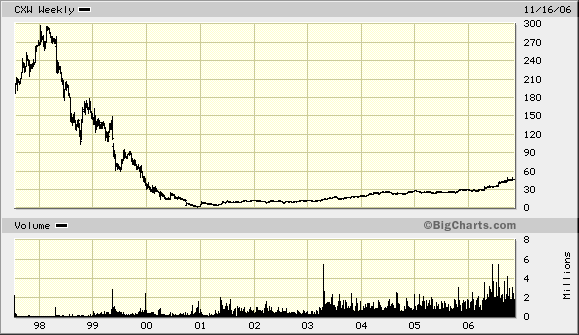I'll provide more history as I update this page, but
the current events start when CCA had spun off, then later merged into, Prison Realty Trust
- a Real
Estate Investment Trust that is exempt from corporate taxes if it meets
certain conditions. One important condition is that it distribute 95% of its
income to shareholders, a provision making REITs attractive to investors. Prison Realty Trust failed to meet those conditions because
of cash
flow problems; it posted a $62
million loss for 1999 and was in default on the terms of its
credit facility.
Wall Street was unimpressed at the company's earlier scheme to
issue junk
bonds. Investors are angry that PZN lost its REIT status and the related
dividend; they are filing
class actions suits against Prison Realty for false claims on Securities
and Exchange Commission documents. Specifically, they are
concerned about the non-disclosure of payments by PZN to CCA. Meanwhile, Prison Realty just paid
a dividend
on their preferred stock (belonging to executives and institutional
partners), which sent the common stock to new lows as shareholders realized they
are not likely to see dividends soon.
In April of 2000, company audits
expressed doubt about the company's solvency. Shares hit a new
52 week low of $2.12 each, down from the 52 week high
of $22.37. In his book The Perpetual Prisoner Machine [see resources],
Joel Dyer notes that outside one CCA facility, there is a placard with the words
"Yesterday's closing stock price." imagine the legitimacy and
confidence that are lost by people driving by seeing the stock price plummet, or
even seeing "Yesterday's Closing Stock Price: $2.12"
[Maybe CCA turns off the sign during times like this?]
Together, CCA and its spin-off Prison
Realty Trust, lost
$265 million: "It's a slim chance, but bankruptcy
is a possibility," says an analyst for First Union Securities. Localities
that have contracts with the companies are concerned about whether guards will
get paid, and how morale or turnover will affect daily operations, including
prison security. As it turns out, the private prison firm was offered a $200 million restructuring plan from its current shareholder Pacific Life
Insurance Co. (It's unlikely that guards or inmates will receive additional
benefits from the insurance company under the plan.) The private prison's
largest shareholder, Dreman Value Management, was pleased at the offer: "We
always maintained that the (prison) business was great, but this has been a
financial engineering disaster."
Shareholder lawsuits still must be
settled on satisfactory terms for the deal to be finalized, but the other
requirement was met when Lehman Bothers refinanced PZN's
$1 billion credit line. At the close of business 26 April, the
price closed below $3 a share again after briefly hitting $3.50 the previous
week. Prices through the first half of May have generally been below $3 a
share. On June 7, the stock hit a new low
of $2.00 and talks
started on financial restructuring to remedy default on credit line.
During the next week, stock rose $1 a share on news that their $1
billion credit line is restructured and they receive a $780
million federal contract.
Instrumental in puling off this contact
was former Federal Bureau of Prisons head J. Michael Quinlan, who is now on the
Board of PZN. He left the FBOP just as an investigation was starting on whether
he silenced an inmate who claimed to have sold
then vice-Presidential candidate Dan Quayle marijuana in the 1970s. The
Federal contract, with guaranteed
95% occupancy rate, provided financial resources to reject
a restructuring offer from Pacific Life Insurance, but a Legg-Mason
stock analyst declared PZN an UNDERPERFORM. Quinlan is now one of the top
executives in the company.
Because the stock has lost 75% of its
value, two of the top executives are leaving, but not without a $1.3
million severance. Of course, there's also been millions in attorney
fees, class action lawsuits from shareholders about the merger and management
fees for restructuring. Share prices bottomed out at $0.18 - yes, 18 cents; that
really inspires confidence in the justice system. They instituted a 10 for 1
split, which does not change the underlying financials of the company, but
prevented them from being removed from the New York Stock Exchange.
The recent news has focused on CCA's
recovery. The stock price is back up again because of a management turnaround
and some generous contracts from federal agencies locking up immigrants. But be
careful of the hype, especially all those investors looking at CCA. While the
short-term chart looks good, here's the longer run perspective (runs through mid
Nov 2006, adjusted for splits):

The question for anyone
hoping to make money off private prisons is whether the excited stories about
the prospects for private prison are for real this time or whether this is the
same as the early mid 1990s hype that preceded a three year sell off? If you've
never read the "risk
factors" in the company's annual report, I' suggest checking it out
before you invest. (link goes to 2005 annual report, but risk factors tend to be
similar across years).
Corrections Corporation Of America A Critical Look At Its First Twenty Years